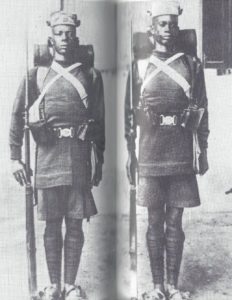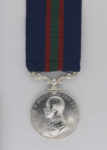Dr Marika Sherwood
Senior Research Fellow
On 7 August 1914 Alhaji Grunshi of the Gold Coast Regiment, marching into the German colony of Togo, returned fire on the German-led police force. His was the first shot fired in what became World War 1. It was also the beginning of the British/French war in Africa to take over Germany’s other colonies: the Cameroons (Kamerun), German East Africa (now Rwanda, Burundi, and Tanzania) and German South-West Africa (now Namibia).
By 25 August the Germans unconditionally surrendered Togo to the Anglo-French force. On the 24th the conquest of Kamerun was begun by a combination of British, French and Belgian troops. The Germans capitulated in February 1916. The South African government took over the conquest of South-West Africa and was granted it in 1919. German East Africa was fought by the West African Frontier Force, the King’s African Rifles (Kenya /Uganda/Nyasaland), the Rhodesia Native Regiment, West Indian and Indian regiments, and even some white troops from South Africa and Rhodesia. This war lasted from 1915 till the armistice was signed in Europe.
Britain’s existing African armies had been much too small, so recruitment was undertaken. This was not just for soldiers, but for ‘carriers’, sometimes called ‘Pioneer corps’. They were needed as there were no vehicles nor animals to carry the officers’ and troops’ necessities. Four to six ‘carriers’ were needed for each officer, fewer for the soldiers, to carry food supplies, arms and even artillery. Women and children were also ‘recruited’, by the British. There is photographic evidence of women digging roads in the Tanganyika!
The numbers recruited, for both the military and as ‘carriers’ varies in the books on this war. Were there a million carriers? Three million? Did the Germans use 350,000 men, women and children? Edward Paice in his book Tip and Run (2007), argues that 105,000 British ‘carriers’ died. And how many soldiers? The numbers given vary from 200,000 to 1 million. There are no data on the numbers disabled. That the historians who researched this history cannot find accurate data makes me wonder not only why data was not kept, but whether the men (and women and children) were ever paid, as surely Treasury accounts should contain this. German General Lettow-Vorbeck in East Africa stated that he had burned all his records. According to Kathleen Bomani, ‘300,000 porters died working for the German troops. This lack of accurate (or any) data, adds to my feelings about the attitudes of both the French and British colonial powers, as exemplified by the names used for African soldiers. For example, ‘Alhaji’ means having been on pilgrimage to Mecca. ‘Grunshi’ is the British mispronunciation of the name of an ethnic group in North-East Gold Coast, the Gurunne. According to historian Yewande Okuleye, ‘soldier’s surnames recruited in South West Nigeria had been replaced with names of towns and villages. As it transpired, this was a common British colonial recruitment practice.’ Were they granted any first names? After all, not all would have been baptised!
But it was not only the military who died. How many of the civilian population died due to starvation, even before the drought and the arrival of Spanish flu? One of General Lettow-Vorbeck’s doctors reported in September 1918 that ‘Behind us we leave destroyed fields … and, for the immediate future, starvation… our track is marked by death, plundering and evacuated villages’. Historian Tim Stapleton reports that ‘German and Allied armies lived off food produced by the local population…. looting did occur…. Germans simply confiscated what they wanted… Britain tended to pay for the grain and livestock they acquired, but there was an underlying element of coercion… It was common to see corpses along the paths … In one village the people’s skulls littered the ground like coconuts’. ‘Some historians estimate that a million people (ie, civilians) died in East Africa as a direct result of the war’.



Recent Comments